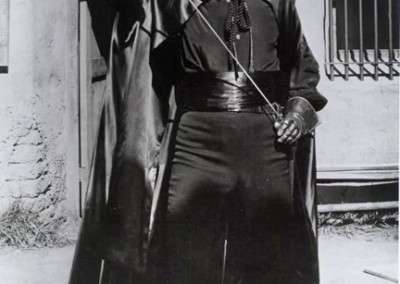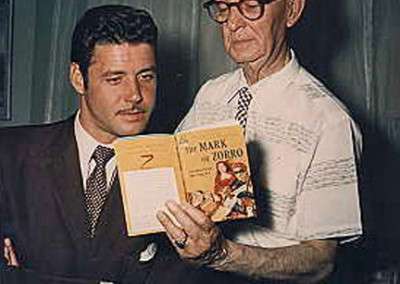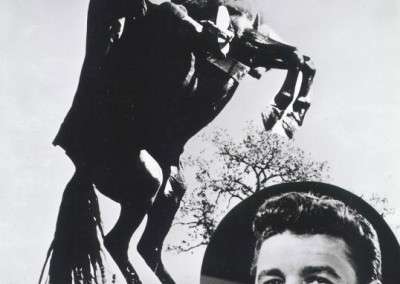Walt Disney was a man of remarkable talent. He has been called many things in his lifetime… artist, showman, animator and American icon. But perhaps his greatest talent was that of clairvoyant, or seer. He seemed to know instinctively what would work, what the public would like. This skill was evident even in the earliest days of the studio. Walt knew that his Mickey Mouse and Silly Symphony cartoon shorts were just a 6 or 7 minute filler for the opening of a feature movie. He knew that in order to keep pace and keep his studio ahead of the game, he needed new and fresh material.
This of course led to the first animated feature film, Snow White and the seven Dwarfs, followed by his True-Life adventure series, his live-action feature films and the Mickey Mouse Club. But his most cherished and popular series (Just ask any Baby-Boomer growing up in the late ‘50’s) was his Zorro action-adventure series. Although it only ran for two seasons, it left an indelible mark on the nation’s early television audience. But a little history on TV’s first action-adventure hero is in order.
The character of Zorro flowed from the pen of a New York–based pulp writer Johnston McCulley. Johnston McCulley (February 2, 1883 – November 23, 1958) authored of hundreds of stories, various screenplays, and fifty novels and in addition to Zorro, he has several other characters to his credit. Zorro, Spanish for “Fox” could be compared to Robin Hood, who helped the oppressed and fight injustice. Although the character has changed somewhat throughout the years, the common image is that of a dashing black-clad masked outlaw who defends the commoners and indigenous peoples of the land against tyrannical officials and other villains. He uses his wits and cunning more than the sword to outwit and humiliate his foes, hence the name Zorro, the Fox. The character debuted in the 1919 story, “The Curse of Capistrano” in the magazine “All Story Weekly” which was serialized. The story proved so popular that Mary Pickford and Douglas Fairbanks used the story as the first picture of their new United Artists studio, called the “Mark of Zorro” a silent film in 1920. The film was such a success that McCulley penned more than 60 more Zorro tales, starting in 1922. His last was published posthumously in 1959. In these stories, Zorro’s secret identity is not known.
McCulley is sometimes inconsistent with the story line. In some stories, he introduces pirates and Native Americans, many who know of his secret identity. In the Curse of Capistrano Don Diego Vega is called “Senor” Zorro. In later stories it becomes “Del La Vega”. The first magazine serial ended with the villain dead and Diego publicly exposed as Zorro, but in the sequel the villain was alive, and the next entry had the double identity still secret. But the story line most embraced is that Don Diego de la Vega is portrayed as a University educated student called back from Spain by his father, Don Alejandro de la Vega, a man with sense of fair play and morality, to fight the injustice of the Spanish commandant Captain Monastario, who is like a tyrant to the people. Diego is a master swordsman, winning fencing medals in Spain. But Diego feels the best way to combat Monastario is to assume role as a Milquetoast rich fop, with no fighting or sword skills. His alter-ego Zorro works at night. (Does the hero “Superman” come to mind?)
Don Diego (Zorro) is a master swordsman and marksman. He is agile, athletic and a skilled acrobat, able to land from great heights, and extremely adept in taking a fall. He is skilled in the use of the bullwhip, which he often uses to swing through gaps between roofs and archways. He is also proficient in unarmed combat, even against numerous foes. And like a “Fox”, his is a calculating and cunning tactician, avoiding brute strength, but relying on a “Fox” like mind and practiced techniques to outmatch his enemies. In some stories, he keeps a small dagger in his left boot, just in case of emergencies. He utilizes his cape as a trip-mat and for blinding foes in a fight. He enjoys humiliating and making a mockery of his opponents, causing them to lose concentration in battle. In addition, Zorro is an expert horseman. He rides a jet-black horse. The horse’ name differs from time to time and in the original story, he had no name. In later stories the horse was named Toronado, Tornado or Tempest. In some versions he rides a white horse named Phantom.
Zorro’s secret identity is known only to his man servant Bernardo. (And in later tales, his Father learns of his identity). He is mute and uses sign language to communicate. He plays an important part in helping Zorro fight injustice. He also pretends to be deaf as well. He adopts the guise of a simple man, sometime foolish and clownish, so if any of Zorro’s foes are near, they think nothing of talking in front of him, paying him no mind. This information is relayed to Don Diego. Sometimes Bernardo will don Zorro’s costume, to confuse the soldiers and keep Diego’s secret safe. Bernardo appeared in the original tales, as well as the Disney version. Other characters in the original tale are his rival is Captain Ramon, Sgt. Pedro Gonzales, Zorro’s enemy but Don Diego’s friend. Also included is his ally Friar Felipe.
DISNEY’S ZORRO
In 1950, McCulley gave the film and TV rights of Zorro to Hollywood agent Mitchell Gertz. He tried to find financing to produce a Zorro series, with no takers. During the planning stages of his Disneyland Park, Walt was looking into ways to finance the park. He believed that Zorro would garner enough interest and in 1952, using his WED Enterprises, he obtained the license for the Zorro stories from Gertz and was planning a number of episodes; hopefully using the proceeds to fund Disneyland. He set up a separate company called “Zorro Productions” in 1953 to produce the stories. After much preliminary work, and Disney’s passion for detail, Disney bought many antique props and furnishings for the sets. Walt than attempted to sell the show, but the TV networks required a pilot episode, something Walt bristled at. Walt stopped work on the endeavor.
In 1954, Walt in his effort to help fund Disneyland, reached an agreement with the ABC Television network. He would produce a weekly TV series for them. At first, there were stories that Zorro would be part of the programming, but ABC decided they wanted the Disneyland Anthology series instead. This was hosted by Walt himself and featured programs from the domains of Fantasyland, Adventureland, Frontierland and Tomorrowland. Viewers were also treated to frequent ‘progress reports’ in which Disneyland construction footage was shown to stimulate the interest of hopefully, future guests. For this, ABC agreed to loan Disney $500.000 and guarantee $4.5 million in loans in return for a one-third ownership in Disneyland.
Even though Disneyland was a monster success, Walt wanted to make it even better and again needed funding to expand the park. Again, Walt turned to ABC, and again they said would fund the improvements for another TV series. With that, Zorro was on its way to the small screen. With the name “Disney”, no pilot was needed and now Walt needed a lead actor for Zorro. With the success of Davy Crockett, many actors would have loved to be Disney’s next superstar. After many screen tests with many high-profile actors, the role fell to Guy Williams, then an unknown actor.
His real name was Armand Joseph Catalano, born January 14th, 1924 in New York City. After coming to the attention of MGM, he appeared several small parts, but he was about to give up acting, until the role of Zorro made him a network TV star. Guy was a perfect choice for Zorro. He could handle the drama and small comedic scenes, and most important, the action scenes successfully. He was also a proficient swordsman. Zorro’s horse was never previously mentioned, and in the Disney series, the horse’ name was Tornado. The horse portraying him was a 7 year old quarter horse named Diamond Decorator. There were also three “Stunt” horses so to speak to perform the different stunts used in the series. One for running, one for the opening credit of Zorro rearing back on Tornado and one used for the fight scenes. Guy also rode Diamond Decorator for publicity and personal appearances as Zorro.
Zorro proved to be the most expensive TV series at the time. With Walt’s attention to detail, the studio’s first permanent sets cost more than $100,000, plus $35,000 on furnishings and additional props brought the cost to another $30,000 dollars. But the realism and authenticity of the sets was well worth the cost. The expenses for each episode were also an industry high, but Walt had high standards for anything with the Disney name. Walt even had Belgium-born fencing master Fred Cavens, the same coach who trained Tyrone Power and Douglas Fairbanks, to school Williams and the cast.
Walt promoted the Zorro show with his Disneyland anthology series. Audiences got their first peek of Guy Williams as Zorro on September, 11th, 1957. The Zorro theme song was also first heard then. The show premiered on October 10th, 1957. Walt Disney continued to promote the show by having Guy Williams saddle up to promote Zorro. One of his most popular venues were rodeos, where he received $2,500 to ride around the arena dressed as Don Diego. Walt also promoted Zorro with live appearances at Disneyland called ”Zorro Days” Accompanying Williams were fellow cast actors Britt Lomond, as the villain, Gene Sheldon as Bernardo and Henry Calvin as Sgt. Garcia. The stars appeared in daily parades and four shows daily. They included Zorro and Monastario battling on the rooftops of Frontierland, and the fourth show was held in Magnolia Park in Frontierland. There were five “Zorro Days” at Disneyland…April 26th -27th, 1958, May 30th-June 1st, 1958, November 27th-30th, 1958, November 26th-29th, 1959 and November 11th-13th, 1960. Unfortunately, that memorable back-lot set is now a parking garage.
Although Zorro was a hit, contractual issues with ABC and the Disney Company over ownership rights caused the series to end after two seasons and 78 episodes. Disney did continue to film four, hour long specials. Zorro has spawned over 40 films, both domestic and foreign, numerous television shows and film serials. There were also numerous radio shows and literally tons of Zorro merchandise, toys and comic books. In addition, the character is in video games and many stage productions. Even Johnston McCulley could not have predicted how popular his character would have become.


























